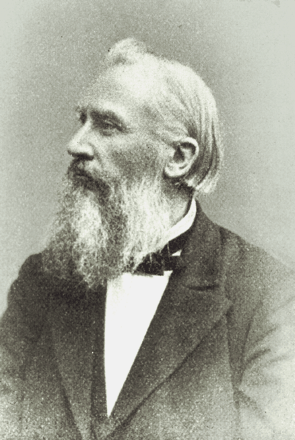<Back to Index>
- Psychiatrist Karl Ludwig Kahlbaum, 1828
- Composer Calixa Lavallée, 1842
- 1st President of Trinidad and Tobago Ellis Emmanuel Innocent Clarke, 1917
PAGE SPONSOR

Karl Ludwig Kahlbaum (December 28, 1828, Driesen - April 15, 1899) was a German psychiatrist. In 1855 he received his medical doctorate at Berlin, and subsequently worked as a physician at the mental asylum in Wehlau. For a period of time he was also a lecturer at the University of Königsberg (1863 - 66), and from 1867 was director of the mental hospital at Görlitz. He would remain at Görlitz for the remainder of his life.
As a psychiatrist, Kahlbaum realized that attempting to group mental disorders based on similarities of outward symptoms was futile, and in his work tried to develop a classification system that grouped mental diseases according to their course and outcome. He is remembered for research done at Görlitz with his associate Ewald Hecker (1843 - 1909) involving studies of young psychotic patients. In their analyses of mental disorders, Kahlbaum and Hecker introduced a classification system that used descriptive terms such as dysthymia, cyclothymia, catatonia, paraphrenia and hebephrenia. In their research they were pioneers in the application of modern clinical practices in the study of mental health.
Kahlbaum referred to Jugendliche Irresein or "juvenile madness", and stressed the importance of parental upbringing to prevent this condition from occurring. In his research of catatonia, he published the monograph, Die Katatonie oder das Spannungsirresein, in which he characterizes the disorder as disturbance in motor functionality that represents a phase in a progressive illness that includes stages of mania, depression and psychosis that typically ends in dementia.
Kahlbaum's work would in time influence German Psychiatrist Emil Kraepelin. Strictly speaking however Kahlbaum's catatonia is not, as is commonly believed, the same as the catatonia found in Emil Kraepelin's concept of dementia praecox. Rather, as Adolf Meyer would later complain with respect to dementia praecox, "Kahlbaum's catatonia was liberally extended so as to include everything that showed catalepsy, negativism, automatism, stereotypy, and verbigeration".
As the 20th century came to its close, the American Psychiatric Association (APA) would declare that occurrences of catatonia were by 1987, rare.
The eponymous "Kahlbaum's syndrome" is a catatonic symptom characterized by continuous and purposeless rhythmic repetition of words and sentences that are meaningless or insignificant.